Skin Rejuvenation Treatments: The Ultimate Overview to Refreshing Your Skin
Skin Rejuvenation Treatments: The Ultimate Overview to Refreshing Your Skin
Blog Article
Exploring Skin Problem: Recognizing and Dealing With Acne Scars for Healthier Skin
Acne scars represent a considerable problem for individuals looking for to keep healthy skin, as they can impact both appearance and self-confidence. Comprehending the various kinds of scars, from atrophic to hypertrophic, is essential for determining ideal treatment alternatives.
Comprehending Acne Scars

The body's all-natural healing process can cause either atrophic scars, which show up as anxieties in the skin, or hypertrophic marks, which are elevated and arise from overproduction of collagen. Furthermore, the psychological toll of acne scars need to not be undervalued; numerous individuals report feelings of embarrassment, anxiousness, and decreased self-confidence. This psychological problem can influence social communications and overall lifestyle.
Addressing acne scars requires an extensive understanding of their development and effect. Awareness of the possibility for long-lasting consequences related to unattended scars can motivate people to look for appropriate treatments. Early treatment and efficient administration strategies can substantially boost skin look and improve mental resilience, emphasizing the significance of recognizing the intricacies surrounding acne marks.
Kinds of Acne Scars
Acne scars can be categorized into distinctive kinds, each showing one-of-a-kind qualities and requiring particular treatment strategies. acne treatment for sensitive skin. The key sorts of acne marks consist of atrophic, hypertrophic, and keloid scars

Hypertrophic scars, in comparison, are increased above the skin level and are the result of too much collagen manufacturing throughout the healing process. They usually continue to be within the limits of the original acne lesion. Keloid marks are comparable yet expand past the initial injury site, forming larger, increased locations that can be agonizing or itchy.
Comprehending these kinds of marks is important for choosing proper therapy options. Various marks might respond much better to certain therapies, such as laser treatments, fillers, or surgical interventions, stressing the relevance of a tailored technique to acne scar management.
Determining Your Scars
When examining the look of your skin, it is important to accurately identify the kind of marks present, as this will inform one of the most reliable therapy strategy. Acne marks normally come under two groups: atrophic and hypertrophic marks. Atrophic marks, which are the most typical, show up as clinical depressions or indentations on the skin. These can better be identified right into ice-pick marks, boxcar marks, and rolling scars, each showing distinctive characteristics and needing various techniques for assessment.
Hypertrophic scars, on the other hand, are elevated and happen due to extreme collagen production throughout the recovery procedure. Acknowledging the particular attributes of your marks-- such as width, depth, and appearance-- is vital for appropriate recognition (acne scars treatment). Additionally, take into consideration the circulation of scars throughout your skin, as this can show the extent and duration of the acne problem
Engaging with a skin specialist can offer important understandings into the nature of your scars, assisting in the differentiation in between different kinds. A thorough understanding of your marks will eventually cause a much more customized and reliable therapy plan, guaranteeing a clearer and healthier skin tone.
Treatment Options Readily Available
Recognizing the details sort browse around here of acne marks present on your skin lays the foundation for checking out reliable therapy choices. Common types of acne marks include atrophic (clinically depressed), hypertrophic (increased), and post-inflammatory erythema.
For atrophic scars, choices such as chemical peels, microneedling, and laser resurfacing are extensively made use of. Chemical peels use acids to eliminate the external layer of skin, promoting new cell development.
Hypertrophic marks can be treated with corticosteroid injections to flatten the mark or laser treatment to decrease redness and boost look. Silicone gel sheets and pressure dressings may likewise help in taking care of increased marks.
Additionally, facial fillers can momentarily fill out clinical depressions from atrophic marks, while medical excision may be ideal for extreme instances. Each treatment alternative has its considerations and benefits, making it important to seek advice from a dermatologist. They can supply tailored suggestions based on the type and seriousness of your scars, as well as your skin type and overall wellness.
Tips for Prevention
Reliable avoidance techniques can dramatically reduce the possibility of creating acne scars. Utilizing non-comedogenic products helps protect against clogged pores, which can exacerbate acne.
Staying clear of need to pop or choose acne lesions is crucial, as this can cause deeper skin damage and increase the risk of scarring. Instead, take into consideration using a cold compress or over the counter treatments to lower swelling and inflammation.
Sun security is another essential element of prevention; ultraviolet (UV) rays can darken marks and prevent the recovery process. Using a broad-spectrum sun block with at the very least SPF 30 daily can secure additional resources the skin and advertise even recovery.
Lastly, maintaining a balanced diet plan rich in vitamins, minerals, and antioxidants supports skin health and wellness and recovery. Remaining moisturized and managing anxiety degrees can additionally play a considerable function in decreasing acne flare-ups. By executing these techniques, individuals can significantly decrease their opportunities of developing acne scars.
Verdict
In final thought, understanding and determining acne scars is necessary for efficient treatment and achieving much healthier skin. Numerous kinds of acne scars, including hypertrophic and atrophic marks, require particular treatments tailored to individual needs.
The body's all-natural healing process click reference can result in either atrophic marks, which show up as anxieties in the skin, or hypertrophic scars, which are raised and result from overflow of collagen. They are more separated into three subtypes: ice pick marks, boxcar marks, and rolling scars. Acne scars usually fall into two categories: hypertrophic and atrophic scars. These can better be classified into ice-pick marks, boxcar marks, and rolling marks, each showing distinctive characteristics and needing different strategies for analysis.
Different types of acne scars, consisting of atrophic and hypertrophic scars, necessitate details interventions customized to individual needs.
Report this page